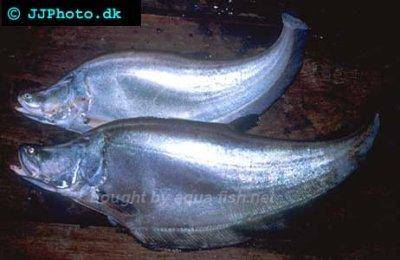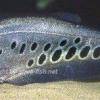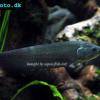Giant featherback - Chitala lopis
Scientific name: Chitala lopis
Common name: Giant featherback
Family: Notopteridae
Usual size in fish tanks: 95 - 100 cm (37.4 - 39.37 inch)
014
Recommended pH range: 6.2 - 7.2
Recommended water hardness: 6 - 16°N (107.14 - 285.71ppm)
0°C 32°F30°C 86°F
Recommended temperature range: 23 - 27 °C (73.4 - 80.6°F)
The way how these fish reproduce: Spawning
Where the species comes from: South Asia
Temperament to its own species: peaceful
Temperament toward other fish species: peaceful
Usual place in the tank: Middle levels
Food and Feeding
The Giant Featherback is a highly carnivorous fish that thrives on a diet rich in meaty foods. In captivity, they readily accept beef heart, bloodworms, and feeder fish. To ensure optimal health and growth, provide a varied diet that includes live or frozen foods. Be cautious when feeding feeder fish to prevent introducing diseases or parasites. These fish are voracious eaters and require large portions to match their size and energy demands.
Origin
Native to Southeast Asia, the Giant Featherback is predominantly found in the Mekong River Basin in Thailand, as well as other slow-moving rivers and large water bodies across the region. These habitats are characterized by warm temperatures, soft substrates, and abundant vegetation, providing the perfect environment for this nocturnal predator to thrive. In the wild, their striking presence and size make them an apex predator in their ecosystem.
Sexing
There are no discernible external differences between male and female Giant Featherbacks. Breeding behaviors or further scientific observation are required to distinguish the sexes effectively.
Breeding
There are currently no reported cases of successful breeding for Chitala lopis in aquariums. Their large size and specific environmental needs make breeding in captivity a challenging prospect for even the most experienced aquarists. In the wild, they are believed to spawn in secluded areas with slow-moving waters.
Lifespan
With proper care, the Giant Featherback can live up to an impressive 50 years. This remarkable lifespan highlights the importance of long-term commitment and meticulous care when keeping this species.
Tank Setup and Requirements
The Giant Featherback requires a massive tank to accommodate its size and activity levels. A tank of at least 2,000 liters (528 gallons) is recommended for adult specimens. These fish are exceptional jumpers, so a tight-fitting lid is essential to prevent escapes. Floating plants can be added to provide shaded areas and mimic their natural habitat, but any other tank décor, including rocks or driftwood, may be rearranged by the fish as they see fit.
Maintain water temperatures between 23-27°C (73.4-80.6°F), a pH of 6.2-7.2, and water hardness between 6-16°N. These parameters closely replicate their natural environment. Install efficient filtration systems to handle their bioload and ensure pristine water conditions. Regular water changes are crucial to prevent the buildup of toxins.
Compatibility
Despite their immense size, Giant Featherbacks are relatively peaceful toward other fish of similar size and temperament. However, their predatory instincts make them unsuitable for tanks with smaller species, which they may view as prey. Due to their territorial nature and space requirements, they are best kept in single-specimen setups or with similarly large and robust tankmates, such as Oscars, Arowanas, or Clown Knifefish. Always monitor for signs of aggression, particularly in confined spaces.
Short Description
The Giant Featherback (Chitala lopis) is a fascinating and challenging species to keep, best suited for highly experienced aquarists with the resources to accommodate its large size and long lifespan. This nocturnal predator is known for its striking appearance, impressive jumping ability, and unique behavior. While they are peaceful toward similarly sized tankmates, their predatory nature and tank size requirements make them a commitment for only the most dedicated fishkeepers.
Pictures
Bought by aqua-fish.net from jjphoto.dk.



 Clown
Clown  Reticulate
Reticulate